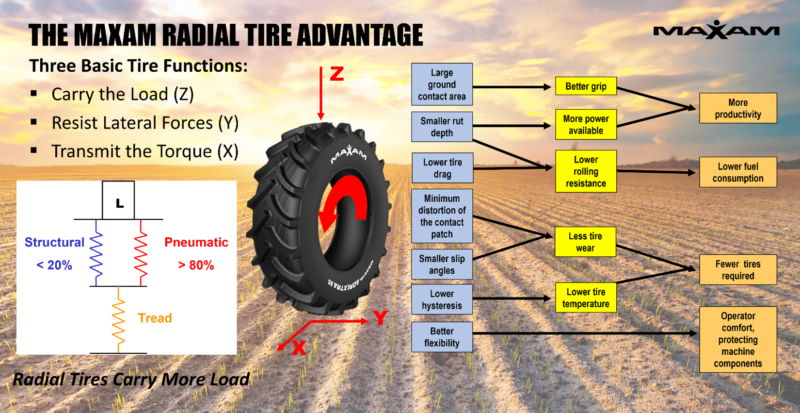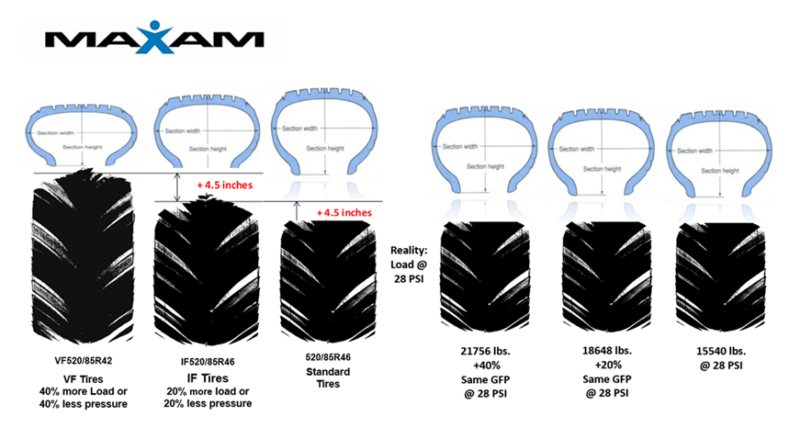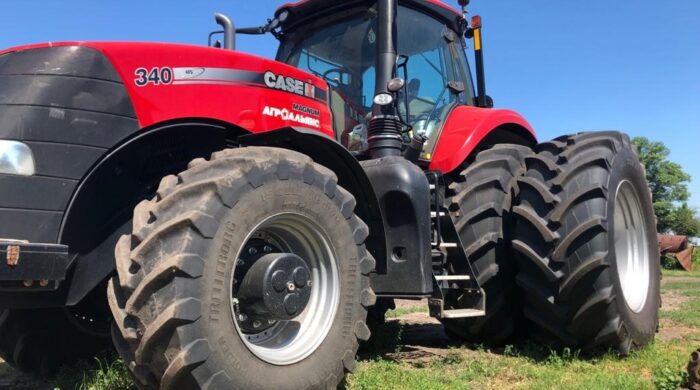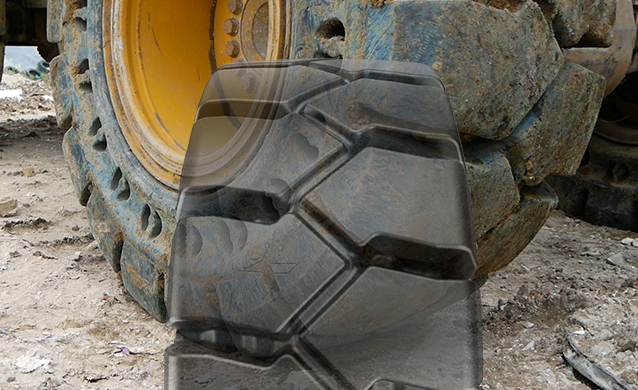Question 38: Why is a tire, when run at slower speed, able to carry more weight at same air pressure, or carry same load at lower air pressure, and how does Central Tire Inflation System impact?
In a previous article, we covered the differences between radial and bias tire construction. In summary, the primary difference between radial tires and bias ply tires is in the tire carcass, as well as the material construction of the tire. The key difference between the two types of construction is how the radial tire uses the “single” radial casing as a “spring mechanism” that pushes the working belts onto the working surface, ensuring a uniform “contact patch” or contact area for the tire tread. This delivers both the necessary traction and friction, carrying the required load in any direction under power. The improved footprint and traction delivered by radial tires have accelerated the adoption of radial tires as the primary construction type on both new and older agricultural equipment. With the performance advantage created by the radial casing, the air pressure in the chamber takes on a larger part of the load carrying capacity, moving from 60% to 80% of the axle load carrying capability:
The radial advantage is delivered by the air pressure in the inner chamber that fluctuates per the given axle load, whether mounted as a single tire, dual, or triple fitment. All tires are a compromise, as well between load and speed, radial casings and rubber compounds have been enhanced over time. This allows the tires to operate at higher speeds and absorb the heat generated by the friction of the road versus a given axle load. Over the last 20 years, we have seen radial tires evolve from the traditional dual speed rating of A8 = 25 MPH / B = 30 MPH to a “D” Rating = 40 MPH capability as the market demands require faster capabilities. In every case, the rubber compounds, as well as casing materials must be engineered to not only carry the loads but have the endurance to deflect or flex up/down as the tire absorbs the energy generated by both load and speed.
The biggest threat to tire failure is excessive heat generation caused by overload or overspeed. Overload occurs when tires are underinflated for the axle load. Whereas overspeed failures occur when tires are either overloaded (not enough air pressure) for the rated speed or operated above their speed rating, increasing the friction coefficient of the tire rubber compounds. As a rule, the key to load bearing capability is the correlation between the actual weight being carried and the machinery speed. If the tire inflation pressure is set to the right inflation pressure based on the axle load for a given speed, the tire is designed to deflect and absorb the heat, delivering performance and endurance. If you slow the machinery speed without changing the air pressure in the chamber (already at a higher pressure), the air in the chamber allows for heavier loads to be carried as heat generation caused by the friction or tire flexing is reduced dramatically, this reduces the heat in the inner chamber that’s normally generated between the air molecules. In all cases, tire manufacturers abide by industry standards that reference principles of temperature and air pressure to determine the optimal speed, weight bearing capability, and resulting heat generation for a given tire size air chamber.
If you choose to lower the air pressure, then the load being carried must be measured so that the correct lower air pressure for that given speed is identified, thus allowing the air molecules in the chamber to heat up without overheating the tire.
The advent of IF or VF Technology has allowed some of the above rules to be re-written, transferring back to the casing materials a great share of the load carrying technology. For agricultural tires, whether using IF or VF technology tires, farmers can either significantly lower air pressure without compromising the carrying capacity of the tire or increasing the weight carried with the same tire footprint (same gross flat plate). Both technologies allow farmers to achieve better yields or greater productivity in the field with heavier or faster machinery. Specifically, VF tire technology construction uses different casing and rubber materials to achieve the benefits mentioned earlier, by delivering the product solutions below in comparison to the standard tire construction:
- VF tires provide the greatest load carrying or axle load capacity at standard air pressures as needed.
- When operated at -40% air inflation pressures, VF tires will reduce soil compaction improving crop yields.
- VF tires are designed to operate safely with a higher heat resistance of the casing despite -40% lower air pressure.
- The ability to lower air pressures also improves the ride and with a greater contact patch (or flotation) as traction improves.
- VF tire pressures, when operating at -40% air inflation, also greatly enhance both traction and stability when on slope fields.
- The above conditions are matched on IF technology tires except the benefits are only 20% greater than standard tires
The growing use of “On-Board” Tire Inflation or Central Inflation Systems technology has created a feedback loop adjustment tool supplied by the machinery that is connected to the tires. This includes the capability to inflate or deflate the tires as needed based on the required speed or working axle load demand. On-board or Central tire inflation systems receive data from either an RFID or sensor tag, located by wheel position on the machinery and gives the operator the capability to adjust the tire inflation pressure in real time and as needed without having to stop the machinery. Whether working in the field at slow speeds or transporting the machinery (roading) from field to field at higher speeds, the ability to adjust the tire air pressures as needed can ensure the following benefits:
- Reduced ground compaction as tire load is based on the actual load per axle or per tire as needed.
- Greater crop yields as the compaction impact on the soil is minimized by the improved tire footprint.
- Improved tire wear and reduced sidewall deflection giving the optimum tire gross flat plate or footprint.
- Improved fuel efficiency as the tire is optimized for each work application or towed implement.
- Greater productivity in the field as the tire’s footprint and traction provide increased efficiency.
MAXAM’s AGRIXTRA product range has been engineered based on a given load or speed to ensure the optimal contact patch without compromising the steering, flotation, traction, or torque transfer capability of the tire. MAXAM is constantly developing new VF tires sizes to not only complement our existing offer, but as well to meet the evolving global demand for higher load, platform, or market technological changes. In addition, MAXAM will also employ our new Ecopoint3 rubber compound technology to rewrite the tire performance rules that will ensure we can deliver value-centered products engineered to exceed grower or farmer expectations based on load, speed, or endurance.
Attachment:
Maxam Ag NA Feedback – Ag Tire Talk – Question 38 – Tire Air Pressures Weight Carrying Capacity





